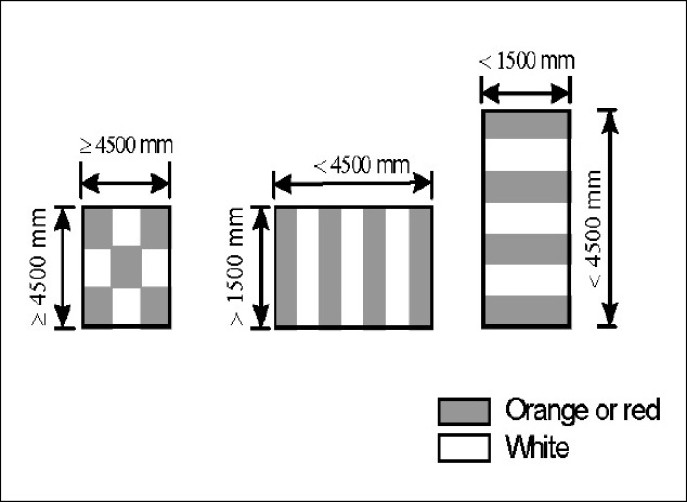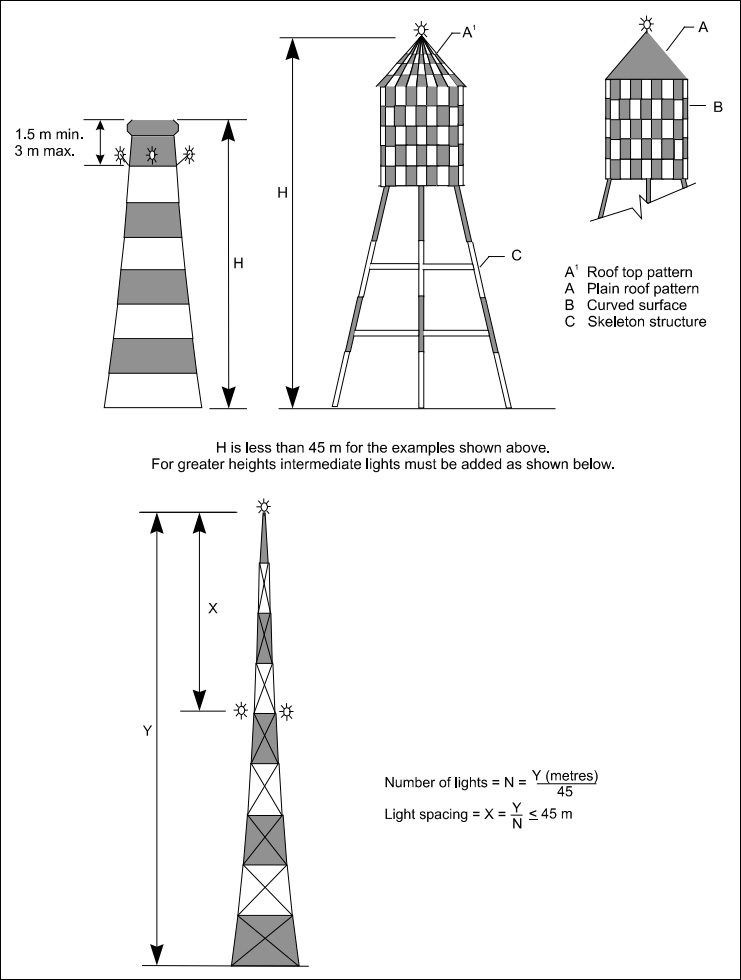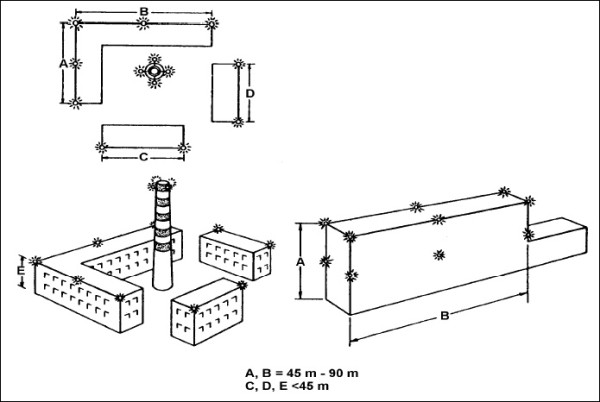Download the PDF consolidation of Part 77 [PDF 325 KB]
For the purpose of this Appendix the term obstacle is used to refer to those objects that the Director has determined to be a hazard under rule 77.21.
(a) A fixed obstacle that extends above the obstacle limitation surfaces required by Part 139 must be marked and, if the aerodrome is used at night, lighted, except that—
(1) the marking may be omitted when the obstacle is lighted by high-intensity obstacle lights by day; and
(2) the lighting may be omitted where the obstacle is a lighthouse and an aeronautical study indicates the lighthouse light to be sufficient; and
(3) such marking or lighting may be omitted when—
(i) the obstacle is shielded by another fixed obstacle already marked or lighted; or
(ii) for a circuit extensively obstructed by immovable objects or terrain, procedures have been established to ensure safe vertical clearance below prescribed flight paths; or
(iii) an aeronautical study shows the obstacle not to be of operational significance.
(b) A fixed obstacle that meets or exceeds any of the standards for determining hazards under rule 77.19, not included in paragraph (a), must be marked or lighted except that—
(1) the marking may be omitted when the obstacle is lighted by high-intensity obstacle lights by day; and
(2) the lighting may be omitted where the obstacle is a lighthouse and an aeronautical study indicates the lighthouse light to be sufficient; and
(3) the marking or lighting may be omitted when—
(i) the obstacle is shielded by another fixed obstacle already marked or lighted; or
(ii) an aeronautical study shows the obstacle not to be of operational significance.
All fixed obstacles to be marked must be coloured, but if this is impracticable, markers or flags must be displayed on or above them, except that the obstacles that are sufficiently conspicuous by their shape, size, or colour need not be otherwise marked.
(a) An obstacle, if its projection on any vertical plane has both dimensions less than 1500 mm, must be marked by a single conspicuous colour being orange or red, unless those colours merge with the background.
(b) An obstacle, if it has essentially unbroken surfaces and its projection on any vertical plane equals or exceeds 4500 mm in both dimensions, must be marked by—
(1) orange and white, or red and white, except where such colours merge with the background; and
(2) a chequered pattern of squares of not less than 1500 mm and not more than 3000 mm on a side, the corners being of the darker colour. See figure B.1.

(c) An obstacle must be marked by alternating contrasting coloured bands if—
(1) it has essentially unbroken surfaces and has one dimension, horizontal or vertical, greater than 1500 mm, and the other dimension, horizontal or vertical, less than 4500 mm; or
(2) it is of skeletal type with either a vertical or a horizontal dimension greater than 1500 mm. See figure B.1.
(d) The bands referred to in paragraph (c) must—
(1) be perpendicular to the longest dimension; and
(2) have a width approximately one seventh of the longest dimension or 30 m, whichever is less; and
(3) be coloured orange and white unless those colours are not conspicuous when viewed against the background; and
(4) be so placed that the bands on the extremities of the obstacle are of the darker colour.
(e) Table B.1 shows a formula for determining band widths to ensure an odd number of bands, thus permitting the extreme bands to be of the darker colour. Also see Figure B.1.
| Longest dimension | ||
|---|---|---|
| Greater than | Not exceeding | Band width |
| 1.5 m | 210 m | 1/7 of longest dimension |
| 210 m | 270 m | 1/9 of longest dimension |
| 270 m | 330 m | 1/11 of longest dimension |
| 330 m | 390 m | 1/13 of longest dimension |
| 390 m | 450 m | 1/15 of longest dimension |
| 450 m | 510 m | 1/17 of longest dimension |
| 510 m | 570 m | 1/19 of longest dimension |
| 570 m | 630 m | 1/21 of longest dimension |
Markers displayed on or adjacent to obstacles must—
(1) be located in conspicuous positions so as to retain the general definition of the obstacle; and
(2) be recognisable in all directions in which an aircraft is likely to approach the object, in clear weather, from a distance of at least—
(i) 1000 m for an obstacle to be viewed from the air; and
(ii) 300 m for an obstacle to be viewed from the ground; and
(3) have a distinctive shape to the extent necessary to ensure they are not mistaken for markers employed to convey other information; and
(4) be such that the hazard presented by the obstacle they mark is not increased.
(a) Flags used to mark obstacles must be—
(1) displayed around, on top of, or around the highest edge of, the object; and
(2) be such that the hazard presented by the obstacle they mark is not increased.
(b) When flags are used to mark extensive obstacles or groups of closely spaced obstacles, they must be displayed at least every 15 m.
(c) Flags used to mark fixed obstacles must—
(1) not be less than 600 mm by 600 mm; and
(2) be orange in colour or a combination of two triangular sections, one orange and the other white, or one red and the other white, except that where such colours merge with the background other conspicuous colours must be used.
(d) Flags used to mark mobile obstacles must—
(1) not be less than 900 mm by 900 mm; and
(2) consist of a chequered pattern—
(i) each square having sides of not less than 300 mm; and
(ii) the colours of each square contrasting with each other and with the background against which they will be seen; and
(iii) coloured orange and white, or red and white, except where such colours merge with the background.
(a) Where an obstacle is required to be lighted, it must be by low-, medium-, or high-intensity obstacle lights, or a combination of such lights.
(b) Light intensity must be such that the hazard presented by the obstacle they mark is not increased.
(c) Where the use of low-intensity obstacle lights would be inadequate or an early special warning is required, then medium or high-intensity obstacle lights must be used.
(d) Medium-intensity obstacle lights must be used, either alone or in combination with low-intensity obstacle lights, where the obstacle is extensive or its height is greater than 45 m.
(e) High-intensity obstacle lights are intended for day use as well as night use.
(f) High-intensity obstacle lights must be used to indicate the presence of an obstacle, if its height exceeds 150 m; or
(a) Where lighting is required, at least one obstacle light must be located at the top of the obstacle except in the case of a chimney type structure where the top lights must be placed sufficiently below the top so as to minimise contamination by emissions.
(b) Where the top of an obstacle is more than 45 m above the level of the surrounding ground, lights must be provided at intermediate levels that—
(1) must be spaced as equally as practicable between the top light and ground level; and
(2) if low-intensity or medium-intensity lights are used, are spaced no more than 45 m apart.
(c) Where high-intensity obstacle lights are used on an obstacle the lights must be spaced no more than 105 m apart.
(d) The number and arrangement of lights at each level to be marked must be such that the obstacle is marked from every angle in azimuth.
(e) Where a light on an obstacle is shielded in any direction by another object, an additional or substitute light must be provided on the obstacle in such a way as to retain its general definition.
(f) The top light must be placed—
(1) to indicate the points or edges of the obstacle that are highest in relation to the obstacle limitation surface; and
(2) to indicate the points or edges of the obstacle that are highest in relation to sea level; and
(3) in the case of a chimney type structure, between 1500 mm and 3000 mm below the top (See Figs B.2 and B.3); and
(4) in the case of a guyed tower or antenna that should have a high intensity obstacle light at the top but where it is impracticable to do so, at the highest practicable point, and a medium-intensity obstacle light showing white mounted on the top.
(g) An extensive obstacle or a group of closely spaced obstacles must—
(1) display top lights on the points or edges of the obstacles highest in relation to the obstacle limitation surface, so as to indicate the general definition and extent of the obstacles; and
(2) if two or more edges are of the same height, display lights on the edge nearest the landing area; and
(3) where low intensity lights are required, be spaced no more than 45 m apart; and
(4) where medium-intensity lights are required, be spaced no more than 90 m apart.


(a) A low-intensity obstacle light on a fixed obstacle must be a fixed red light having an intensity that is—
(1) conspicuous in the surroundings in which it is placed; and
(2) not less than 10 cd of red light.
(b) A low intensity obstacle light on a mobile obstacle must—
(1) be yellow or, if yellow is not suitable, red; and
(2) flash at a frequency between 60 and 90 per minute; and
(3) have an effective intensity not less than 40 cd of yellow or red light.
A medium-intensity obstacle light must—
(1) be red except when used in conjunction with a high-intensity obstacle light, in which case it must be white; and
(2) flash at a frequency between 20 and 60 per minute; and
(3) have an effective intensity of not less than 1600 cd of red light.
A high-intensity obstacle light must—
(1) be white; and
(2) flash simultaneously at a rate between 40 and 60 per minute; and
(3) except when located on a tower supporting overhead lines, have an effective intensity that is variable and dependent on the background luminance as follows:
| Background luminance | Effective intensity |
|---|---|
| above 500 cd/m² | 200 000 cd minimum |
| 50 to 500 cd/m² | 20 000 cd ± 25% |
| less than 50 cd/m² | 2000 cd ± 25% |